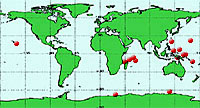|
When working with the ASAR data for SAE 2008-2009 website, I stumbled upon two interesting images, which show strange formations on the surface of Antarctic waters.
The more or less well-educated circles (3 to 35 km in diameter) have "sharp" edges and a "hole" in the middle. They most likely represent the areas on the water surface, where there is ripple (or/and the small waves) under the wind influence. In the middle is then calm water that the calm wind (at least in the horizontal direction) may indicate. Around these areas is relatively calm water again.
In the research of simultaneous data from MERIS, I noticed that particularly dense and cold, but low clouds (cumulus and/or cumulus pileus or stratocumulus lenticularis) are located above the mentioned circles.
If the temperature gradient between the water and the cold Antarctic air over the water is larger as in the surrounding area, it can be assumed, that the sea surface will more steamed, the vertical air currents emerge. They take the vapour to the top, where a water vapour transforms into ice crystals and forms a cloud.
Since the inversion layer close to Antarctica coast is quite a deep, the relative warm sea air pushed by the streams from below goes further to the periphery, where it cools and descends to the water surface. Where it will be warmed up and goes toward the middle again, where there is relatively low pressure. The process is relatively stable as long as the spatial-limited energy comes from the water and there are weak horizontal winds.
The wind (according to MERIS supplied data) is actually really weak (less 1 m/s).
It is less likely, that the occasion for the hot water could be one of the eddies, which was detached from the Circumpolar Current (which is still warmer than near Antarctic water). More likely it could be a vortex of icy air from the continent that provides the large temperature gradient between the sea and air.
 Meanwhile, the circles on the sea were observed also in warm zones, not far from the island groups or shoals. Meanwhile, the circles on the sea were observed also in warm zones, not far from the island groups or shoals.
From the lack of data over the open ocean, we can not make any conclusions for these areas.
As another possible reason for the formation of the “circles” (in addition to already mentioned) could also be the sea-breeze phenomena. A sea-breeze front is created by a sea-breeze. The cold air from the sea meets the warmer air from the land and creates a boundary. On this occasion the cumulus and cumulonimbus clouds can be emerged. There, where the warm air rises, the "circles" could be developed.
The conclusion of this possibility is following: the “circles” must be developed only as a result of the just emerging of the small (Ø up to 40 km) convective clouds, they can not be observed under the clouds that already exist and are moving with the wind.
|

![]()
![]()
![]()
![]()